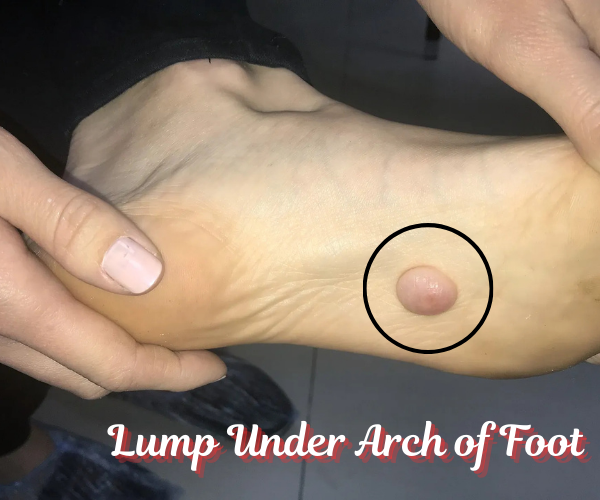Painful Lump Under Arch of Foot? Causes and Treatments You Should Know
Do you have a painful lump under arch of foot? You are not alone. Many people notice a small bump...

Do you have a painful lump under arch of foot? You are not alone. Many people notice a small bump or swelling in the middle of their foot, and it can make walking, standing, or even wearing shoes uncomfortable. The good news is, most lumps are not dangerous, and knowing the cause can help you treat it quickly. In this guide, we’ll explore the main causes, how to recognize them, and what you can do to feel better.
What Causes a Lump Under the Arch of the Foot?
The arch of your foot is more than just a curve; it supports your whole body when you walk or run. A lump here can appear for several reasons. One common cause is plantar fibroma, a small, firm knot of tissue that grows in the arch. It can feel like a marble under your skin and sometimes hurts when you step.
Another possibility is a ganglion cyst, a fluid-filled lump that often appears near joints or tendons. While usually harmless, ganglion cysts can press on nearby nerves, causing pain or tingling.
Injury or trauma to your foot can also lead to lumps. A small bruise or swelling after a fall, a twist, or wearing tight shoes may appear as a lump. Even repetitive stress from sports or long walks can create inflammation that forms a noticeable bump.
How to Recognize a Problem Lump
Not every lump under your foot is dangerous, but some signs mean you should see a doctor. A lump may be a cause for concern if it:
- Grows quickly or changes shape
- Is very painful or prevents walking
- Feels warm, red, or looks infected
- Is hard to move or attached to deeper tissues
If you notice any of these signs, don’t wait. Early care can prevent more serious problems. Even mild lumps can become painful if left untreated.
Plantar Fibroma: What You Need to Know
A plantar fibroma is a common cause of a lump under the arch of the foot. It forms from extra fibrous tissue in the plantar fascia, the thick band of tissue along the bottom of your foot.
These lumps are usually firm and grow slowly. Some people may not feel pain at first, but pressure from walking or standing can make it uncomfortable. Wearing supportive shoes and using orthotic inserts can help reduce stress on the arch and ease discomfort.
In some cases, physical therapy or injections may be recommended. Rarely, surgery is needed if the fibroma grows large or continues to cause pain.
Ganglion Cysts: Fluid-Filled Lumps
A ganglion cyst is another type of lump that can appear under the arch. It is a pocket of fluid that forms along tendons or joints. Ganglion cysts are usually soft and can move slightly under the skin.
While often painless, a cyst can press on nerves in the foot, causing a tingling or burning feeling. Simple treatments include cushioning the area, avoiding pressure, or gently draining the cyst under medical supervision.
Most ganglion cysts shrink on their own over time, but a doctor can help if the lump is persistent or painful.
Other Possible Causes
Not all lumps are fibromas or cysts. Other possible causes include:
- Lipomas: Soft, fatty lumps that usually don’t hurt.
- Bone spurs: Hard bumps on bones caused by extra growth.
- Infections or abscesses: Red, warm, and painful lumps that need prompt medical care.
- Tumors: Rarely, a lump can be a sign of something serious.
Knowing what kind of lump you have is key to finding the right treatment. A professional evaluation is the safest way to identify the cause.
When to See a Doctor
You should see a doctor if a lump:
- Causes constant pain
- Changes quickly in size or color
- Makes walking difficult
- Shows signs of infection
Even if the lump is mild, consulting a foot specialist can give you peace of mind and prevent further problems. Early care often leads to faster relief and better outcomes.
Home Treatments That May Help
Some home treatments can reduce discomfort while you arrange professional care:
- Rest and Elevation: Avoid activities that make the lump hurt. Raise your foot when resting.
- Ice Packs: Reduce swelling by applying ice for 10-15 minutes at a time.
- Supportive Shoes: Shoes with good arch support reduce pressure on the lump.
- Orthotics or Inserts: Custom insoles can help distribute weight evenly.
- Gentle Stretching: Stretching the plantar fascia or calf muscles may ease tension.
Remember, home remedies are not a cure; they only help relieve pain temporarily. Always follow professional advice for long-term care.
Medical Treatments You Should Know
Doctors may suggest different treatments based on the lump type and severity:
- Physical Therapy: Helps reduce pain and improve foot function.
- Corticosteroid Injections: Reduce inflammation for fibromas or painful cysts.
- Surgery: Considered only if other treatments fail or the lump interferes with walking.
- Medication: Pain relievers or anti-inflammatory drugs can ease discomfort.
Choosing the right treatment depends on your diagnosis, activity level, and comfort. A foot specialist can guide you toward the safest and most effective options.
Preventing Lumps Under the Arch
While not all lumps can be prevented, you can reduce your risk by taking care of your feet:
- Wear shoes with proper arch support
- Avoid tight or poorly fitted shoes
- Stretch your feet and calves regularly
- Maintain a healthy weight to reduce pressure on the feet
- Avoid repetitive stress injuries by varying activities
Good foot care is essential. Healthy feet make walking, running, and playing much easier and pain-free.
Coping With Pain
Pain from a lump under the arch can affect daily life. Here are some tips to manage discomfort:
- Use cushioned footwear: Pads or orthotics reduce pressure.
- Take breaks: Avoid standing or walking for long periods when possible.
- Gentle massage: Massaging the arch can ease tension and soreness.
- Monitor symptoms: Keep track of changes in size, pain, or mobility.
Even small changes can improve comfort and prevent the problem from worsening.
When Surgery Might Be Necessary
Surgery is usually the last option for a painful lump. Doctors consider surgery if:
- Conservative treatments fail
- The lump grows or becomes more painful
- Walking or daily activities are affected
Surgical procedures remove the lump and relieve pressure on surrounding tissues. Recovery usually involves rest, supportive footwear, and gradual return to normal activities. Most people experience relief and regain mobility.
Key Takeaways
A lump under the arch of foot can have many causes, from plantar fibromas to cysts or injuries. Most lumps are not dangerous but can cause discomfort if untreated. Knowing when to see a doctor, using home treatments, and wearing supportive shoes can make a big difference.
Early action is important. Even if a lump seems small, professional evaluation ensures the right treatment and prevents future complications.
Foot health matters at every age. Paying attention to changes, supporting your feet, and getting timely care keeps you active and pain-free. For more information on foot conditions and expert advice, visit arizonafoot.com for trusted guidance and treatment options.




